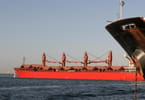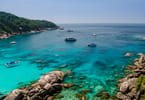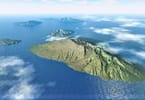The coco de mer palm of the Seychelles is the stuff of legend. Its seeds – the largest and heaviest in the world – were once believed to grow on trees beneath the waves of the Indian Ocean, and to hold great healing powers. Even when it later turned out that the palm grows on dry land, new folklore emerged: To produce this seed, the male and female plants embrace each other on a stormy night, or so a local story goes.
The legends may be just that, but the palm still has unique appeal. “The coco de mer is the only charismatic plant that can rival the giant panda or the tiger,” says Stephen Blackmore at the Royal Botanic Garden Edinburgh, UK. Now the science behind the charismatic palm’s seeds is proving to be just as fascinating.
So how does a plant that grows in poor quality soil on just two islands produce record-breaking seeds that reach half a metre in diameter and can weigh in at around 25 kilograms?
They found that the leaves have only about one-third of the nitrogen and phosphorus concentrations seen in the leaves of other trees and shrubs growing on the Seychelles. Also, before old leaves are shed, the palm efficiently withdraws most of the nutrients from them and recycles them. Investing so little into the foliage means the palm has more to invest in its fruit.
Caring parent
But that’s not the only way the foliage helps fuel fruit growth. The huge, pleated leaves are remarkably effective at funnelling water down the trunk during rain showers. Kaiser-Bunbury and his colleagues showed that this stream of water also picks up any nutrient-rich detritus on the leaves – dead flowers, pollen, bird faeces and more – and washes it down into the soil immediately around the base of the palm. Consequently, the nitrogen and phosphorus concentrations in the soil 20 centimetres from the trunk were at least 50 per cent higher than in the soil just 2 metres away.
Blackmore has seen first-hand how efficiently the leaves channel water – better than some gutters on local buildings, he says. “But to think about it in terms not just of water flow but of nutrients was a very significant leap of thinking and adds much to the understanding of this amazing tree,” Blackmore adds.
Hans Lambers at the University of Western Australia in Crawley, who studies the way plant species have adapted to incredibly low phosphorus levels in soil in south-western Australia, says the nutrient-channelling leaves of the coco de mer are an “entirely different strategy”.
The discovery is linked to another remarkable thing about the palm: it seems to be unique in the plant kingdom in caring for the seedlings after they germinate. Many trees have evolved seeds that travel – on the wind or in the gut of an animal – so that seedlings don’t compete with their parent for the same resources. Stranded on two islands and unable to float, coco de mer seeds usually don’t travel very far.
But the researchers found that the seedlings benefit from growing in the shadow of the parent, because they have access to the more nutritious soil there.
“This is exactly what fascinated my colleagues and me most about Lodoicea,” says Kaiser-Bunbury. “We do not know of another [plant] species that does this.”
Pesky siblings
This still doesn’t explain why the seeds are so large. According to one theory, we have to go back to the dying days of the dinosaurs for an explanation. About 66 million years ago, the ancestral form of the palm probably relied on animals to disperse its relatively large seeds – but it perhaps lost this mechanism when the sliver of continental crust that includes the Seychelles broke away from what is now India, isolating the palm.
This meant the seedlings had to adapt to growing in the gloomy shadows of their parents. Because the large seeds contained a good supply of nutrients, the seedlings were already well equipped to do so, and eventually outcompeted most of the other tree species in the ecosystem: to this day, coco de mer palms are the dominant species in their forests.
Under the unusual conditions of forests dominated by a single species, sibling competition – rather than competition between species – drove evolution, says Kaiser-Bunbury. This meant the palm gradually grew larger and larger seeds to provide seedlings with an even bigger reserve of nutrients to boost chances of surviving against its cousins.
Kevin Burns at the Victoria University of Wellington, New Zealand, studies the way that plants evolve on isolated islands, like the Seychelles, and says that the coco de mer seems to follow a general evolutionary pattern. “Plants tend to evolve large seeds after they colonise isolated islands, and island plant species often have much larger seeds than their mainland relatives,” he says. “Big seeds generally house more competitive seedlings.”
The coco de mer palm hasn’t yielded all of its secrets yet, though. Exactly how the female flowers – the largest of any palm – are pollinated remains a mystery. Blackmore suspects bees are involved, but other researchers think lizards might transfer pollen from the male trees’ 1.5-metre-long, phallic-looking catkins. Local legend, meanwhile, suggests that male trees actually tear themselves from the ground on stormy evenings and lock in a passionate carnal embrace with females. It’s the kind of story that adds to the allure of the palm.
Source:- New Scientist – Journal reference: New Phytologist,
WHAT TO TAKE AWAY FROM THIS ARTICLE:
- Hans Lambers at the University of Western Australia in Crawley, who studies the way plant species have adapted to incredibly low phosphorus levels in soil in south-western Australia, says the nutrient-channelling leaves of the coco de mer are an “entirely different strategy”.
- About 66 million years ago, the ancestral form of the palm probably relied on animals to disperse its relatively large seeds – but it perhaps lost this mechanism when the sliver of continental crust that includes the Seychelles broke away from what is now India, isolating the palm.
- Kaiser-Bunbury and his colleagues showed that this stream of water also picks up any nutrient-rich detritus on the leaves – dead flowers, pollen, bird faeces and more – and washes it down into the soil immediately around the base of the palm.























